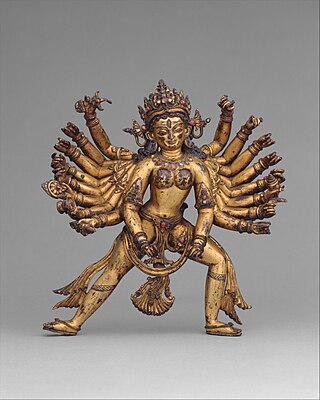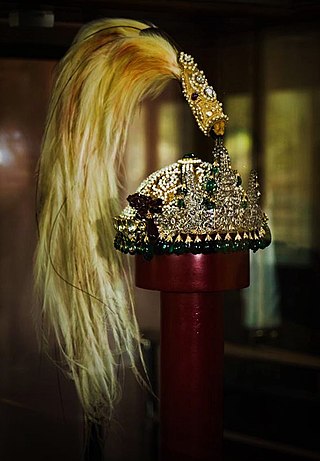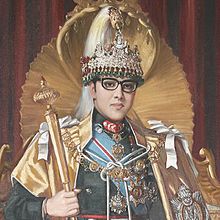
Kathmandu, officially the Kathmandu Metropolitan City, is the seat of federal government and the most populous city in Nepal. As of the 2021 Nepal census, there were 845,767 inhabitants living in 105,649 households and approximately 4 million people in its surrounding agglomeration. It is located in the Kathmandu Valley, a large valley surrounded by hills in central Nepal, at an altitude of 4,344 feet above sea level.

Birendra Bir Bikram Shah Dev, was King of Nepal from 1972 until his assassination in 2001. He was the eldest son of King Mahendra.

The Shah dynasty, also known as the Shahs of Gorkha or the Royal House of Gorkha, was the ruling Chaubise Thakuri dynasty and the founder of the Gorkha Kingdom from 1559 to 1768 and later the unified Kingdom of Nepal from 1768 to 28 May 2008.

Dashain or Bada'dashain, also referred as Vijaya Dashami in Sanskrit, is a major Hindu religious festival in Nepal and the Indian states of Sikkim, West Bengal, Assam, South India, and Sri Lanka. It is also celebrated by other religions of Nepal and elsewhere in the world, including among the Lhotshampa of Bhutan and the Burmese Gurkhas of Myanmar. The festival is also referred as Nauratha, derived from the Sanskrit word for the same festival Navaratri which translates to Nine Nights.

The Nepalese royal massacre occurred on 1 June 2001 at the Narayanhiti Palace, the then-residence of the Nepali monarchy. Nine members of the royal family, including King Birendra and Queen Aishwarya, were killed in a mass shooting during a gathering of the royal family at the palace. A government-appointed inquiry team named Crown Prince Dipendra as perpetrator of the massacre. Dipendra slipped into a coma after shooting himself in the head.

The Narayanhiti Palace Museum is a public museum in Kathmandu, Nepal located east of the Kaiser Mahal and next to Thamel. The museum was created in 2008 from the complex of the former Narayanhiti Palace following the 2006 revolution. Before the revolution, the palace was the residence and principal workplace of the monarch of the Kingdom of Nepal, and hosted occasions of state.
Mainali (मैनाली) is a surname found within the Hindu community of Kumaoni and Nepali Brahman and Chhetri, primarily living in the Kumaon and Garhwal regions of Uttarakhand state of India and all over Nepal. Mainali are Joshi and claim their ancestry to the Vedic Sage Upamanyu.

Hanuman Dhoka is a complex of structures with the Royal Palace of the Malla kings and also of the Shah dynasty in the Durbar Square of central Kathmandu, Nepal.The Hanuman Dhoka Palace gets its name from the stone image of Hanuman, the Hindu deity, that sits near the main entryway. 'Dhoka' means door or gate in Nepali. The buildings were severely damaged in the 2015 earthquake.

The coronation of the Nepalese monarch was a rājyābhiṣeka, a Hindu religious ceremony in which the King of Nepal was crowned. The last coronation was held on 4 June 2001 for King Gyanendra. The Kingdom of Nepal was the last Hindu monarchy in the world at the time of its dissolution in 2008.
Coronations in Asia in the strict sense are and historically were rare, as only a few monarchies, primarily in Western Asia, ever adopted the concept that the placement of a crown symbolised the monarch's investiture. Instead, most monarchies in Asia used a form of acclamation or enthronement ceremony, in which the monarch formally ascends to the throne, and may be presented with certain regalia, and may receive homage from his or her subjects. This article covers both coronations and enthronement.

The architectural heritage of Kathmandu city is integral to that of the Kathmandu valley since all monuments have evolved over centuries of craftsmanship influenced by Hindu and Buddhist religious practices. The architectural treasure of the Kathmandu valley has been categorized under the well known seven groups of heritage monuments and buildings. In 2006, UNESCO declared these seven groups of monuments as a World Heritage Site (WHS). The seven monuments zones cover an area of 188.95 hectares, with the buffer zone extending to 239.34 hectares. The Seven Monument Zones (Mzs) inscribed originally in 1979 with a minor modification in inscribed year as 2006, are: Five monuments in Kathmandu – Durbar square of Hanuman Dhoka, Hindu temples of Pashupatinath and Changunarayan, the Buddha stupas of Swayambu and Boudhanath; and two monuments outside Kathmandu city limits, in the satellite towns of Patan and Bhktapur – Durbar square at Patan, Durbar square at Bhaktapur. Brief details of the five Kathmandu city monuments are elaborated here.
Rajopadhyaya also called Newari Brahmin is the main division of Newar Brahmins in Nepal. The Rajopadhyayas claim to be originated in Kānyakubja or modern day Kannauj, in the north of India, a city with a prestigious history from where the Bahuns also claim to come. They along with Bahuns claim to be sub-division of Kānyakubja Brāhmins.

Indra Jātrā, also known as Yenyā Punhi is the biggest religious street festival in Kathmandu, Nepal. "Ye" means the old Newari name for "Kathmandu", "Ya" means “Celebration”, and "Puhni" means full moon so together means the birthday of the old city of Kathmandu. The celebrations consist of two events, Indra Jātrā and Kumāri Jātrā. Indra Jātrā is marked by masked dances of deities and demons, displays of sacred images, and tableaus in honor of the deity Indra, the king of heaven. Kumāri Jātrā is the chariot procession of the living goddess Kumari.

Crown Prince Trailokya was, as the eldest son of King Surendra of Nepal, the heir apparent to the throne of Nepal. He died under suspicious circumstances before his father, paving the way for Trailokya's young son Prithvi to ascend the throne.

General Prince Narendra Bikram Shah was the second son of King Surendra. The prince was exiled to India because of his involvement in a conspiracy against the Rana dynasty.

The coronation of Vajiralongkorn (Rama X) as king of Thailand took place on 4 May 2019 at the Grand Palace, Bangkok. He ascended the throne at the age of 64 upon the death of his father, Bhumibol Adulyadej, on 13 October 2016, accepting the accession invitation by Prem Tinsulanonda, president of the Privy Council, on 1 December 2016. The coronation was held within just three years after his accession to the throne in 2016 because of an appropriate length of time to pass after the death and funeral of Bhumibol Adulyadej and the arrangement of the ceremony after the last such rite having been held in 1950.

Taleju Temple is a Hindu temple dedicated to Taleju Bhawani, the royal goddess of the Malla dynasty of Nepal. It was built in 1564 by Mahendra Malla and is located in Hanuman Dhoka, Kathmandu Durbar Square, a UNESCO World Heritage Site. Inside the temple, there is a shire dedicated to Taleju Bhawani, and Kumari Devi. Taleju Temple is only opened once a year on the occasion of Dashain.
The Tribhuvan Sadan is a mansion in the Narayanhiti Palace, Kathmandu, Nepal. It is known for being the site of the Nepalese royal massacre where ten members of the royal family, including King Birendra, Queen Aishwarya, and Crown Prince Dipendra were killed. The mansion was formerly occupied by King Tribhuvan and his family and later by Dipendra, Crown Prince of Nepal. The Tribhuvan Sadan was demolished after the orders of the Queen Mother Ratna however It is currently being reconstructed.
The wedding of Crown Prince Birendra and Aishwarya was held on 27 February 1970 in Kathmandu, Nepal. The wedding was attended by more than 300 international guests. Around 50 heads of state were invited. The King of Laos, the President of India and the Governor-General of Ceylon attended the wedding while other countries sent their representatives. Crown Prince Birendra was aged 24 and Aishwarya was 20 at the time of the wedding.













